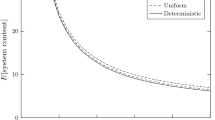Abstract
We develop a queueing model for an appointment-based service system that consists of two queues in tandem: the appointment queue followed by the service queue. Customers join the appointment queue when they call for appointments, stay there (not physically) until the appointment time comes, and then leave the appointment queue and may physically join the service queue, and wait there until served, or become a no-show. The probability of becoming a no-show depends on the time spent in the appointment queue. We build a Tandem Queue model that explicitly captures the dependence between these two queues. We then derive several performance measures of interest, such as service utilization and customer long-run average waiting times in both queues. We also develop several approximation methods to compute the long-run average waiting time in the service queue, including one which is particularly useful when service times in that queue are not exponential.











Similar content being viewed by others
References
Bailey, N.T.J.: A study of queues and appointment systems in hospital out-patient departments, with special reference to waiting-times. J. R. Stat. Soc. Ser. B 14, 185–199 (1952)
Bean, A.G., Talaga, J.: Predicting appointment breaking. J. Health Care Mark. 15(1), 29–34 (1995)
Cayirli, T., Veral, E., Rosen, H.: Designing appointment scheduling systems for ambulatory care services. Health Care Manag. Sci. 9(1), 47–58 (2006)
Chakraborty, S., Muthuraman, K., Lawley, M.: Sequential clinical scheduling with patient no-shows and general service time distributions. IIE Trans. 42(5), 354–366 (2010)
Creemers, S., Lambrecht, M.: Queueing models for appointment-driven systems. Ann. Oper. Res. 178(1), 155–172 (2010)
Denton, B., Gupta, D.: A sequential bounding approach for optimal appointment scheduling. IIE Trans. 35(11), 1003–1016 (2003)
Doi, M., Chen, Y.M., Ōsawa, H.: A queueing model in which arrival times are scheduled. Oper. Res. Lett. 21(5), 249–252 (1997)
Dreiher, J., Froimovici, M., Bibi, Y., Vardy, D.A., Cicurel, A., Cohen, A.D.: Nonattendance in obstetrics and gynecology patients. Gynecol. Obstet. Investig. 66(1), 40–43 (2008)
Fries, B.E., Marathe, V.P.: Determination of optimal variable-sized multiple-block appointment systems. Oper. Res. 29(2), 324–345 (1981)
Gallucci, G., Swartz, W., Hackerman, F.: Brief reports: impact of the wait for an initial appointment on the rate of kept appointments at a mental health center. Psychiatr. Serv. 56(3), 344–346 (2005)
Girish, M.K., Hu, J.Q.: Higher order approximations for tandem queueing networks. Queueing Syst. 22(3), 249–276 (1996)
Green, L.V., Savin, S.: Reducing delays for medical appointments: a queueing approach. Oper. Res. 56(6), 1526–1538 (2008)
Green, L.V., Savin, S., Wang, B.: Managing patient service in a diagnostic medical facility. Oper. Res. 54(1), 11–25 (2006)
Grunebaum, M., Luber, P., Callahan, M., Leon, A.C., Olfson, M., Portera, L.: Predictors of missed appointments for psychiatric consultations in a primary care clinic. Psychiatr. Serv. 47(8), 848–852 (1996)
Gupta, D., Denton, B.: Appointment scheduling in health care: challenges and opportunities. IIE Trans. 40(9), 800–819 (2008)
Hassin, R., Mendel, S.: Scheduling arrivals to queues: a single-server model with no-shows. Manag. Sci. 54(3), 565–572 (2008)
Jansson, B.: Choosing a good appointment system—a study of queues of the type (d, m, 1). Oper. Res. 14(2), 292–312 (1966)
Johnson, M.A., Taaffe, M.R.: Matching moments to phase distributions: mixtures of Erlang distributions of common order. Stoch. Models 5(4), 711–743 (1989)
Kaandorp, G.C., Koole, G.: Optimal outpatient appointment scheduling. Health Care Manag. Sci. 10(3), 217–229 (2007)
Klassen, K.J., Rohleder, T.R.: Scheduling outpatient appointments in a dynamic environment. J. Oper. Manag. 14(2), 83–101 (1996)
Kortbeek, N., Zonderland, M.E., Boucherie, R.J., Litvak, N., Hans, E.W.: Designing cyclic appointment schedules for outpatient clinics with scheduled and unscheduled patient arrivals. Memorandum 1968, Department of Applied Mathematics, University of Twente, Enschede, The Netherlands (2011)
Kulkarni, V.G.: Modeling and Analysis of Stochastic Systems. Chapman & Hall, London (1995)
LaGanga, L.R., Lawrence, S.R.: Clinic overbooking to improve patient access and increase provider productivity. Decis. Sci. 38(2), 251–276 (2007)
Liu, N., Ziya, S.: Panel size and overbooking decisions for appointment-based services under patient no-shows. Forthcoming in Prod. Oper. Manag. (2014)
Liu, N., Ziya, S., Kulkarni, V.G.: Dynamic scheduling of outpatient appointments under patient no-shows and cancellations. Manuf. Serv. Oper. Manag. 12(2), 347–364 (2010)
Luo, J., Kulkarni, V.G., Ziya, S.: Appointment scheduling under patient no-shows and service interruptions. Manuf. Serv. Oper. Manag. 14(4), 670–684 (2012)
Mercer, A.: Queues with scheduled arrivals: a correction, simplification and extension. J. R. Stat. Soc. Ser. B 35(1), 104–116 (1973)
Muthuraman, K., Lawley, M.: A stochastic overbooking model for outpatient clinical scheduling with no-shows. IIE Trans. 40(9), 820–837 (2008)
Neuts, M.F.: Matrix-geometric Solutions in Stochastic Models: An Algorithmic Approach. Johns Hopkins University Press, Baltimore (1981)
Patrick, J., Puterman, M.L., Queyranne, M.: Dynamic multi-priority patient scheduling for a diagnostic resource. Oper. Res. 56(6), 1507–1525 (2008)
Pegden, C.D., Rosenshine, M.: Scheduling arrivals to queues. Comput. Oper. Res. 17(4), 343–348 (1990)
Robinson, L.W., Chen, R.R.: A comparison of traditional and open-access policies for appointment scheduling. Manuf. Serv. Oper. Manag. 12(2), 330–346 (2010)
Robinson, L.W., Chen, R.R.: Estimating the implied value of the customer’s waiting time. Manuf. Serv. Oper. Manag. 13(1), 53–57 (2011)
Stein, W.E., Côté, M.J.: Scheduling arrivals to a queue. Comput. Oper. Res. 21(6), 607–614 (1994)
Wang, P.P.: Optimally scheduling N customer arrival times for a single-server system. Comput. Oper. Res. 24(8), 703–716 (1997)
Zacharias, C., Armony, M.: Panel Sizing and Appointment Scheduling in Outpatient Medical Care. Working paper, Stern School of Business, New York University, New York, NY (2013)
Acknowledgments
The work of the third author is supported in part by the National Science Foundation grant CMMI 1234212.
Author information
Authors and Affiliations
Corresponding author
Rights and permissions
About this article
Cite this article
Luo, J., Kulkarni, V.G. & Ziya, S. A Tandem Queueing model for an appointment-based service system. Queueing Syst 79, 53–85 (2015). https://doi.org/10.1007/s11134-014-9427-5
Received:
Revised:
Published:
Issue Date:
DOI: https://doi.org/10.1007/s11134-014-9427-5




